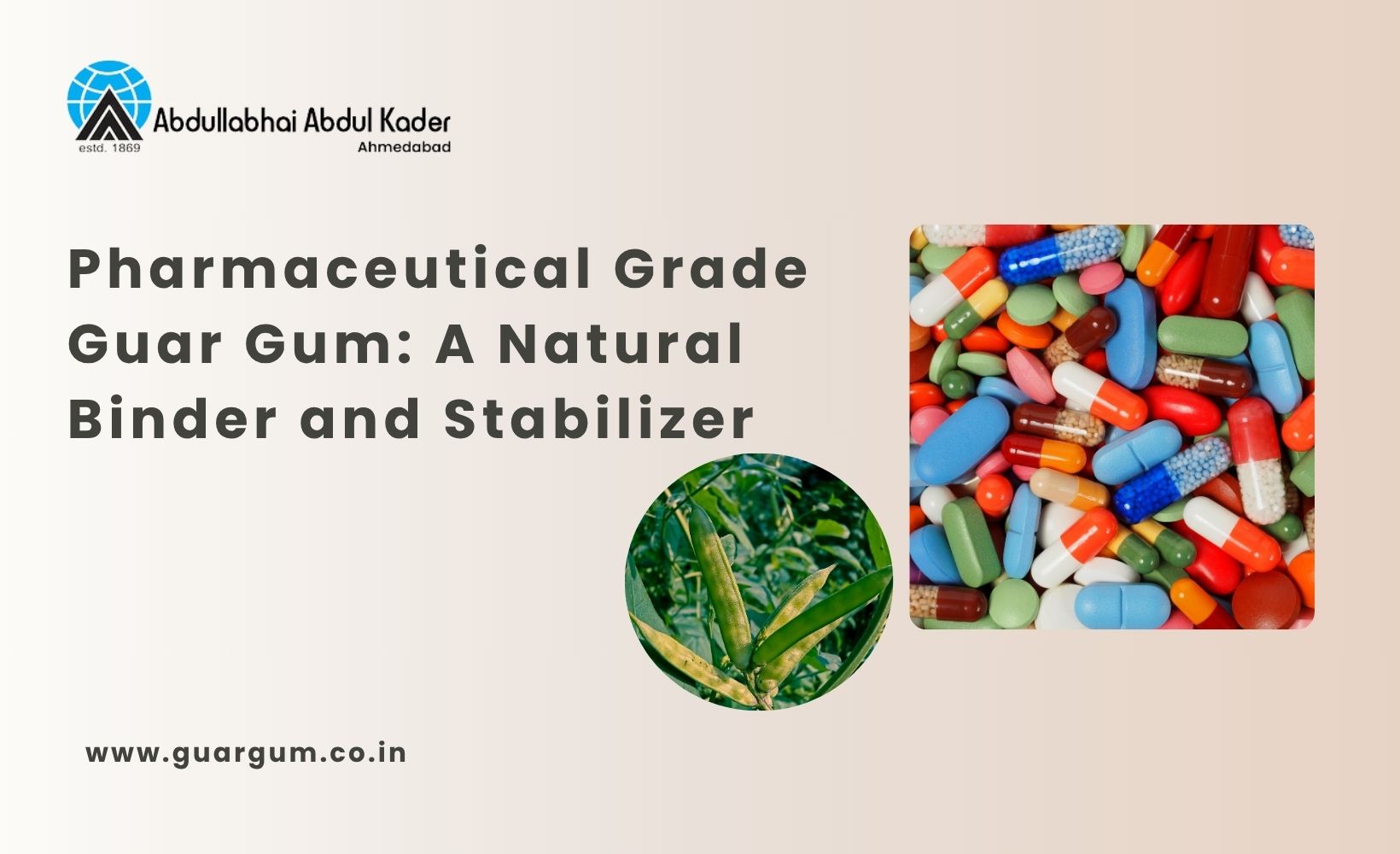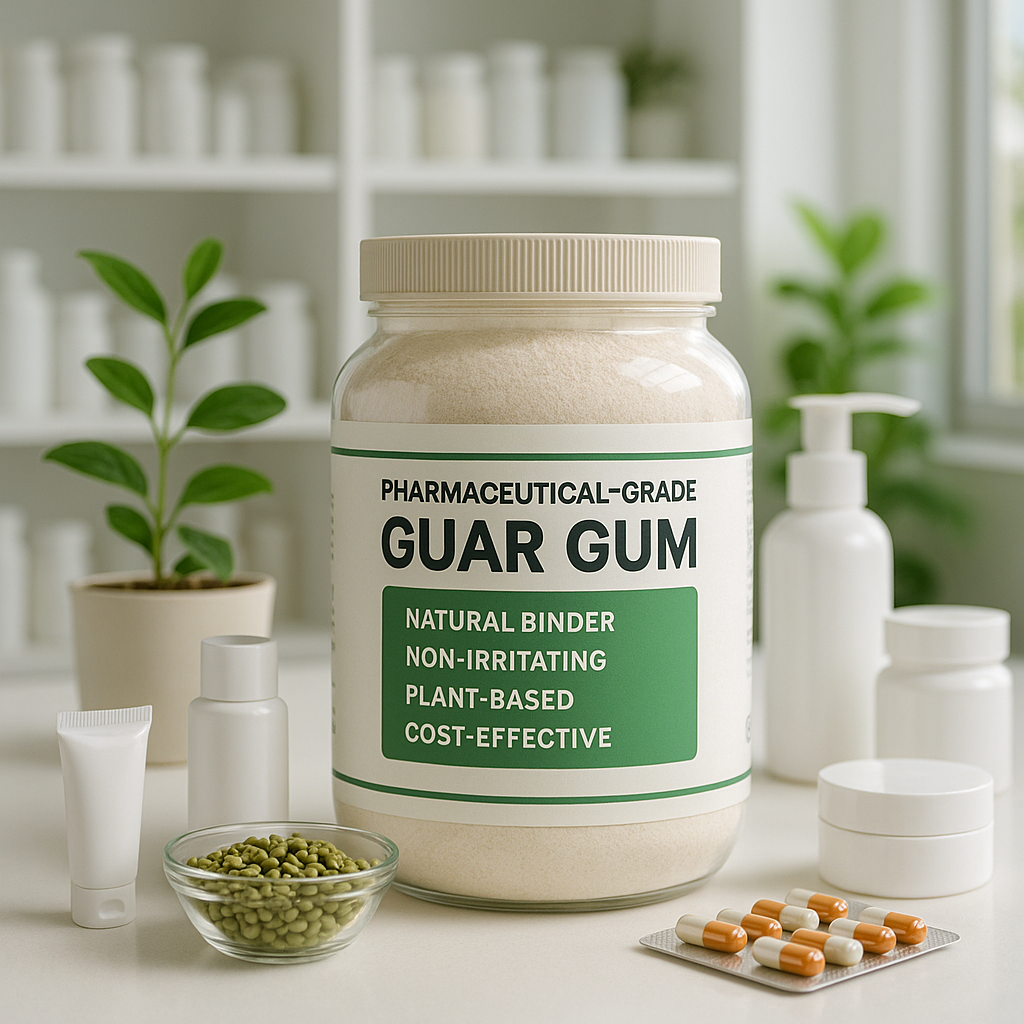
Pharmaceutical grade guar gum is a high-quality, natural polysaccharide derived from the guar plant (Cyamopsis tetragonoloba), which is grown primarily in India and Pakistan. Guar gum is known for its ability to thicken, bind, and stabilize formulations, making it an invaluable ingredient in the pharmaceutical industry.
While standard guar gum is commonly used in food, cosmetics, and industrial applications, pharmaceutical grade guar gum meets the rigorous standards required for medicinal use. It is produced under stringent quality controls to ensure purity, consistency, and safety for use in drug formulations.
Pharmaceutical grade guar gum is primarily used as a binder, disintegrant, emulsifier, and thickening agent in various pharmaceutical products, including tablets, capsules, suspensions, and topical formulations. Its natural and non-toxic properties make it an ideal choice for those seeking plant-based, sustainable, and safe ingredients in pharmaceutical applications.
Properties of Pharmaceutical Grade Guar Gum
Pharmaceutical grade guar gum is characterized by several important properties that make it suitable for use in the production of pharmaceutical formulations:
- High Purity
Pharmaceutical grade guar gum is produced with strict attention to purity. It is carefully processed to remove impurities and ensure that the final product is free from contaminants. This makes it safe for use in medicinal formulations. - Water Solubility
Guar gum is water-soluble, which allows it to easily hydrate in the presence of water and form viscous solutions or gels. This property is critical for its use as a binder and stabilizer in various pharmaceutical applications. - Viscosity and Thickening
Guar gum can significantly increase the viscosity of a solution without altering the taste or stability of the final product. This property makes it ideal for suspensions, syrups, and other liquid formulations that require thickening. - Gelling and Binding
One of the key applications of pharmaceutical grade guar gum is as a binder in tablet formulations. It helps hold the active ingredients together and ensures uniformity and consistency in dosage. Additionally, guar gum’s gelling ability is utilized in controlled-release drug formulations.
.png)
- Non-Toxicity and Biocompatibility
Being a natural ingredient, pharmaceutical grade guar gum is non-toxic and biocompatible, making it a safe choice for use in pharmaceutical formulations, particularly in oral dosage forms. - Sustained Release Properties
Guar gum’s ability to swell and form a gel structure makes it an excellent choice for sustained-release drug formulations. It helps slow down the release of active ingredients, ensuring that the medication is delivered over a longer period of time, which improves patient compliance and therapeutic efficacy.
Applications of Pharmaceutical Grade Guar Gum
Pharmaceutical grade guar gum is used in various applications within the pharmaceutical industry due to its versatility and natural properties:
- Tablet Binders
Guar gum is commonly used as a binder in tablet formulations. In this application, it helps to hold the ingredients together, ensuring that the tablets remain intact and uniform. It also facilitates the smooth disintegration of tablets in the digestive system. Guar gum is preferred for its ability to improve the texture and binding of tablets without compromising the bioavailability of active ingredients. - Controlled Release and Sustained Release Drugs
Guar gum is often used in controlled-release drug formulations. Its ability to form gels and swell in the presence of water allows for the slow release of active ingredients over an extended period. This results in longer-lasting effects and reduces the frequency of dosing, which can improve patient adherence to treatment regimens.
- Suspensions and Emulsions
Pharmaceutical grade guar gum is used in liquid formulations, such as suspensions and emulsions, where it serves as a thickening agent and stabilizer. It helps maintain uniform dispersion of solid particles in suspensions and prevents the separation of ingredients in emulsions, thereby ensuring consistent dosing and stability of the product. - Capsules and Oral Powders
Guar gum is also used in capsule formulations as a stabilizer and binder. It ensures that the contents of the capsule are evenly distributed and helps prevent clumping or settling. In oral powders, guar gum aids in improving flowability and ensuring uniform distribution of active ingredients. - Topical and Transdermal Formulations
Guar gum is used in topical pharmaceutical formulations, such as creams, lotions, and gels, to improve texture and consistency. It helps to stabilize emulsions and enhances the product’s ability to spread evenly on the skin. Guar gum’s gelling properties also make it suitable for transdermal patches, where it helps control the release of active ingredients through the skin.
Advantages of Pharmaceutical Grade Guar Gum
- Natural and Plant-Based
Pharmaceutical grade guar gum is a plant-based ingredient, making it suitable for those seeking natural, non-synthetic alternatives in their pharmaceutical formulations. It is also a preferred choice for vegetarian, vegan, and gluten-free formulations. - Non-Irritating and Safe for Sensitive Skin
Guar gum is non-irritating and safe for use in pharmaceutical products designed for sensitive skin. It is widely used in topical products such as creams, lotions, and ointments for its mildness and ability to improve skin hydration. - Cost-Effective
Compared to other synthetic binders and stabilizers, guar gum is relatively inexpensive and widely available, making it an economical choice for pharmaceutical manufacturers. - Sustainability
Guar gum is sourced from a renewable plant, which makes it an eco-friendly ingredient. Its cultivation requires relatively low amounts of water and pesticides, making it a sustainable choice for manufacturers looking to reduce their environmental footprint.

Quality Standards for Pharmaceutical Grade Guar Gum
Pharmaceutical grade guar gum must meet several quality standards to ensure that it is suitable for use in drug formulations:
- Purity and Microbial Limits
Pharmaceutical grade guar gum should be free from contaminants, such as heavy metals, pesticides, and microorganisms. It must meet strict microbial limits to ensure that it is safe for human consumption and use. - Viscosity Specifications
The viscosity of pharmaceutical grade guar gum must fall within a specific range to ensure consistent performance in pharmaceutical applications. This is particularly important in tablet binders, suspensions, and controlled-release formulations. - Regulatory Compliance
Pharmaceutical grade guar gum must comply with regulatory standards, such as those set by the U.S. Food and Drug Administration (FDA) and the European Medicines Agency (EMA). It should be manufactured in compliance with Good Manufacturing Practices (GMP) to ensure its safety, efficacy, and consistency. - Certifications
Pharmaceutical grade guar gum is often certified for quality and safety, with certifications such as ISO 9001:2015 and Kosher or Halal certifications, depending on the target market.
Conclusion
Pharmaceutical grade guar gum is a highly versatile and natural ingredient used in a wide range of pharmaceutical applications. From tablet binding to controlled-release drug formulations, suspensions, and topical products, its natural properties make it an ideal choice for manufacturers looking for safe, effective, and plant-based ingredients. With its ability to improve the texture, stability, and consistency of pharmaceutical products, guar gum remains an essential component in modern drug development.
As demand for natural, sustainable ingredients grows, pharmaceutical grade guar gum is set to play an even larger role in the industry, providing a reliable, eco-friendly alternative to synthetic additives while maintaining high standards of quality and safety.



